Factors Affecting Social Learning in Nearby Pockets on Tropical Campus Grounds: Towards a Sustainable Campus
Abstract
:1. Introduction
2. Literature Review
2.1. Sustainable Pocket Settings and Their Factors
2.2. Social Learning and Education
2.3. Sustainable Social Learning Settings On-Campus Ground
2.4. Research Gap and Justification of This Study
2.5. Theoretical Base and Hypothesis of the Study
3. Materials and Methods
3.1. Selected Site of the Study
3.2. Sample Selection
3.3. Questionnaire Procedure
3.4. Validity and Reliability of the Survey
3.5. Data Analysis Procedure
4. Empirical Results
4.1. Demographic Characteristic Variable
4.2. Social Learning and Pocket Settings Factors
4.3. Bivariate Analysis of the Study Variables
4.4. Multivariate Analysis of the Study Variables
5. Discussion
5.1. Limitations and Future Directions
5.2. Theoretical Contribution of the Study
5.3. Practical Contribution of the Study
6. Conclusions
Author Contributions
Funding
Institutional Review Board Statement
Informed Consent Statement
Data Availability Statement
Conflicts of Interest
References
- Giddings, B.; Charlton, J.; Horne, M. Public squares in European City Centers. Urban Des. Int. 2011, 16, 202–212. [Google Scholar] [CrossRef]
- Currie, M.A. A design framework for small parks in ultra-urban, metropolitan, suburban and small town settings. Urban Des. 2016, 22, 76–95. [Google Scholar] [CrossRef]
- Douglas, O.; Lennon, M.; Scott, M. Green space benefits for health and well-being: A life-course approach for urban planning, design and management. Cities 2017, 66, 53–62. [Google Scholar] [CrossRef]
- Salih, S.A.; Ismail, S. Determining the Factors Affecting Social Interaction in the Parks of Baghdad City, Iraq. Archnet-IJAR 2018, 12, 40–52. [Google Scholar] [CrossRef]
- Moulay, A.; Ujang, N.; Said, I. Legibility of neighborhood parks as a predicator for enhanced social interaction towards social sustainability. Cities 2017, 61, 58–64. [Google Scholar] [CrossRef]
- Salih, S.A.; Ismail, S.; Ujang, N.; Mustafa, F.A.; Ismail, N.A. Pocket settings for enhancing social learning experience on campus ground: A verbal-visual preference survey. Ain Shams Eng. J. 2023, 14, 102134. [Google Scholar] [CrossRef]
- Baur, J.W.; Tynon, J.F. Small-Scale Urban Nature Parks: Why Should We Care? Leis. Sci. 2010, 32, 195–200. [Google Scholar] [CrossRef]
- Tabassum, S. Environmental Response of Small Urban Parks in Context of Dhaka City. J. Phys. 2018, 953, 1–19. [Google Scholar] [CrossRef]
- Kerishnan, P.B.; Maruthaveeran, S. Factors contributing to the usage of pocket parks―A review of the evidence. Urban For. Urban Green. 2021, 58, 126985. [Google Scholar] [CrossRef]
- Armato, F. Pocket Park: Product Urban design. Des. J. 2017, 20 (Suppl. S1), S1869–S1878. [Google Scholar] [CrossRef]
- Shahhoseini, H.; Kamal, B.K.; Maulan, S. Visual preferences of small urban parks based on spatial configuration of place. Int. J. Archit. Eng. Urban Plan. 2015, 25, 84–93. [Google Scholar]
- Towers, D.; Lynch, J. What kind of outdoor educator do you want to become? Trying something different in outdoor studies in higher education. J. Hosp. Leis. Sport Tour. Educ. 2017, 21, 117–121. [Google Scholar] [CrossRef]
- Hecke, L.V.; Ghekiere, A.; Cauwenberg, J.; Veitch, J.; Bourdeaudhuij, I.; Dyck, D.; Clarys, P.; Weghe, N.; Deforche, B. Park characteristics preferred for adolescent park visitation and physical activity: A choice-based conjoint analysis using manipulated photographs. Landsc. Urban Plan. 2018, 178, 144–155. [Google Scholar] [CrossRef]
- Mertens, L.; Van Cauwenberg, J.; Veitch, J.; Deforche, B.; Van Dyck, D. Differences in park characteristic preferences for visitation and physical activity among adolescents: A latent class analysis. PLoS ONE 2019, 14, e0212920. [Google Scholar] [CrossRef]
- Hafner, K.; Zasada, I.; Zanten, B.T.; Ungaro, F.; Koetse, M.; Piorr, A. Assessing landscape preferences: A visual choice experiment in the agricultural region of Märkische Schweiz, Germany. Landsc. Res. 2018, 43, 846–861. [Google Scholar] [CrossRef]
- Peker, E.; Ataöv, A. Exploring the ways in which campus open space design influences students’ learning experiences. Landsc. Res. 2019, 45, 310–326. [Google Scholar] [CrossRef]
- Peschardt, K.K.; Schipperijn, J.; Stigsdotter, U.K. Use of Small Public Urban Green Spaces (SPUGS). Urban For. Urban Green. 2012, 11, 235–244. [Google Scholar] [CrossRef]
- Belčáková, I.; Slámová, M.; Demovičová, Z. Importance of Urban Green Areas in the Context of Current and Future Global Changes: Lessons Learned from a Case Study in Bratislava (Slovakia). Sustainability 2022, 14, 14740. [Google Scholar] [CrossRef]
- Nordh, H.; Ostby, K. Pocket parks for people: A study of park design and use. Urban For. Urban Green. 2013, 12, 12–17. [Google Scholar] [CrossRef]
- Ding, Y.; Li, D.; Sang, H. Park Characteristics and Changes in Park Visitation before, during, and after COVID-19 Shelter-in-Place Order. Sustainability 2022, 14, 3579. [Google Scholar] [CrossRef]
- Hussein, H.; Omar, Z.; Ishak, S.A. Sensory Garden for an Inclusive Society. Asian J. Behav. Stud. 2016, 1, 33–43. [Google Scholar] [CrossRef]
- Lau, S.S.; Lin, P.; Qin, H. A preliminary study on environmental performances of pocket parks in high-rise and high-density urban context in Hong Kong. Int. J. Low-Carbon Technol. 2012, 7, 215–225. [Google Scholar] [CrossRef]
- Peschardt, K.K.; Stigsdotter, U.K. Evidence for Designing Health Promoting Pocket Parks. Archnet—IJAR 2014, 8, 149–164. [Google Scholar] [CrossRef]
- Leng, H.; Han, B. Effect of Environmental Planning on Elderly Individual Quality of Life in Severe Cold Regions: A Case Study in Northeastern China. Sustainability 2022, 14, 3522. [Google Scholar] [CrossRef]
- Abd El-Aziz, N.A. Potentials of creating pocket parks in high-density residential neighborhoods: The case of Rod El Farag, Cairo city. Int. J. Dev. Sustain. 2015, 4, 805–824. [Google Scholar]
- Ibrahim, N.; Fadzil, N.H.; Saruwono, M. Learning Outside Classrooms on Campus Ground: A case study in Malaysia. Asian J. Behav. Stud. 2018, 3, 131–139. [Google Scholar] [CrossRef]
- Ibrahim, N.; Fadzil, N.H. Informal Setting for Learning on Campus: Usage and Preference. Procedia-Soc. Behav. Sci. 2013, 105, 344–351. [Google Scholar] [CrossRef]
- Rea, T. Informal learning outdoors. In Perspectives on Participation and Inclusion: Engaging Education, 1st ed.; Gibson, S., Haynes, J., Eds.; Continuum Publishers: New York, NY, USA, 2009; pp. 122–131. [Google Scholar]
- Destin, M.; Rosario, R.J.; Vossoughi, S. Elevating the Objectives of Higher Education to Effectively Serve Students from Diverse Socioeconomic Backgrounds. Policy Insights Behav. Brain Sci. 2021, 8, 59–66. [Google Scholar] [CrossRef]
- Oblinger, D. Leading the Transition from Classrooms to Learning Spaces. Educ. Q. J. 2005, 1, 14–18. [Google Scholar]
- Keppell, M.; Souter, K.; Riddle, M. Physical and Virtual Learning Spaces in Higher Education: Concepts for the Modern Learning Environment; IGI Global: Hershey, PA, USA, 2011. [Google Scholar]
- Valtonen, T.; Leppänen, U.; Hyypiä, M.; Kokko, A.; Manninen, J.; Vartiainen, H.; Sointu, E.; Hirsto, L. Learning environments preferred by university students: A shift toward informal and flexible learning environments. Learn. Environ. Res. 2020, 24, 371–388. [Google Scholar] [CrossRef]
- Matthews, K.E.; Andrews, V.; Adams, P. Social learning spaces and student engagement. High. Educ. Res. Dev. 2011, 30, 105–120. [Google Scholar] [CrossRef]
- Neely, A.D.; Marone, V. Learning in parking lots: Affinity spaces as a framework for understanding knowledge construction in informal settings. Learn. Cult. Soc. Interact. 2016, 11, 58–65. [Google Scholar] [CrossRef]
- Fisher, K. Building Better Outcomes: The Impact of School Infrastructure on Student Outcomes and Behaviour; Training and Youth Affairs: Department of Education: Canberra, Australia, 2000. [Google Scholar]
- Fisher, K. Research into Identifying Effective Learning Environments. Evaluating Quality in Educational Facilities 2005. Available online: http://www.oecd.org/edu/innovation-education/37905387.pdf (accessed on 13 July 2023).
- Yang, M.; Chau, A. Social involvement and development as a response to the campus student culture. Asia Pac. Educ. Rev. 2011, 12, 393–402. [Google Scholar] [CrossRef]
- Hedges, H. The “fullness of life”: Learner interests and educational experiences. Learn. Cult. Soc. Interact. 2018, 23, 100258. [Google Scholar] [CrossRef]
- Maheran, Y.; Fadzidah, A.; Fadhilah, R.; Farha, S. A Review of Criteria for Outdoor Classroom in Selected Tertiary Educational Institutions in Kuala Lumpur. Mater. Sci. Eng. 2017, 291, 012014. [Google Scholar] [CrossRef]
- Zanariah, K.; Norsidah, U. Perception towards Sustainability Polytechnic Campus in Malaysia. Alam Cipta J. 2014, 7, 15–26. [Google Scholar]
- Shamsudin, S.; Ismail, S.; Nordin, S.; Al-Mamun, A. Examining the Effect of Extracurricular Activities on Academic Achievements among the Public University Students in Malaysia. Asian Soc. Sci. J. 2014, 10, 171–177. [Google Scholar] [CrossRef]
- Nordh, H.; Alalouch, C.; Hartig, T. Assessing restorative components of small urban parks using conjoint methodology. Urban For. Urban Green. 2022, 10, 95–103. [Google Scholar] [CrossRef]
- Salih, S.A.; Ismail, S.; Mseer, A. Pocket parks for promoting social interaction among residents of Baghdad City. Archnet-IJAR 2020, 14, 393–408. [Google Scholar] [CrossRef]
- Bandura, A. Social Learning Theory; Prentice-Hall: Englewood Cliffs, NJ, USA, 1977. [Google Scholar]
- Kaplan, R.; Kaplan, S. The Experience of Nature: A Psychological Perspective; Cambridge University Press: Cambridge, UK, 1989. [Google Scholar]
- Ministry of Higher Education (MoHE). Available online: https://www.mohe.gov.my/ (accessed on 16 November 2023).
- Creswell, J. Research Design: Qualitative, Quantitative and Mixed Methods Approaches; SAGE Publications: Thousand Oaks, CA, USA, 2014. [Google Scholar]
- Universiti Malaya. About University Malaya. Available online: https://www.um.edu.my/ (accessed on 5 January 2023).
- Universiti Putra Malaysia. Universiti Putra Malaysia: Prospectus 2018–2019; CoSComm, UPM: Selangor, Malaysia, 2019. [Google Scholar]
- Taherdoost, H. Sampling Methods in Research Methodology; How to Choose a Sampling Technique for Research. Int. J. Acad. Res. Manag. 2016, 5, 18–27. [Google Scholar] [CrossRef]
- Sheriff, N.M.; Abdullah, N. Research Universities in Malaysia: What Beholds? Asian J. Univ. Educ. 2017, 13, 35–50. [Google Scholar]
- Yamane, T. Statistics: An Introductory Analysis; Harper and Rao: New York, NY, USA, 1973. [Google Scholar]
- De Vaus, D. Surveys in Social Research; Routledge: Abingdon, UK, 2013. [Google Scholar]
- Peschardt, K.K.; Stigsdotter, U.K.; Schipperrijn, J. Identifying Features of Pocket Parks that May Be Related to Health Promoting Use. Landsc. Res. J. 2014, 41, 79–94. [Google Scholar] [CrossRef]
- Shrotryia, V.K.; Dhanda, U. Content Validity of Assessment Instrument for Employee Engagement. SAGE Open 2019, 9, 1–7. [Google Scholar] [CrossRef]
- Cohen, D.A.; Marsh, T.; Williamson, S.; Han, B.; Derose, K.P.; Golinelli, D.; McKenzie, T.L. The Potential for Pocket Parks to Increase Physical Activity. Am. J. Health Promot. 2014, 28, 19–26. [Google Scholar] [CrossRef] [PubMed]
- Yang, C.; Shi, S.; Runeson, G. Associations between Community Parks and Social Interactions in Master-Planned Estates in Sydney, Australia. Sustainability 2022, 14, 3496. [Google Scholar] [CrossRef]
- Gibson, S.C. “Let’s go to the park” an investigation of older adults in Australia and their motivations for park visitation. Landsc. Urban Plan. 2018, 180, 234–246. [Google Scholar] [CrossRef]
- Kim, Y.L.; Lee, S.M. Effect of Satisfaction in Major at University on Academic Achievement among Physical Therapy Students. J. Phys. Ther. Sci. 2015, 27, 405–409. [Google Scholar] [CrossRef]
- Gao, D.; Tan, L.; Mo, X.; Xiong, R. Blue Sky Defense for Carbon Emission Trading Policies: A Perspective on the Spatial Spillover Effects of Total Factor Carbon Efficiency. Systems 2023, 11, 382. [Google Scholar] [CrossRef]
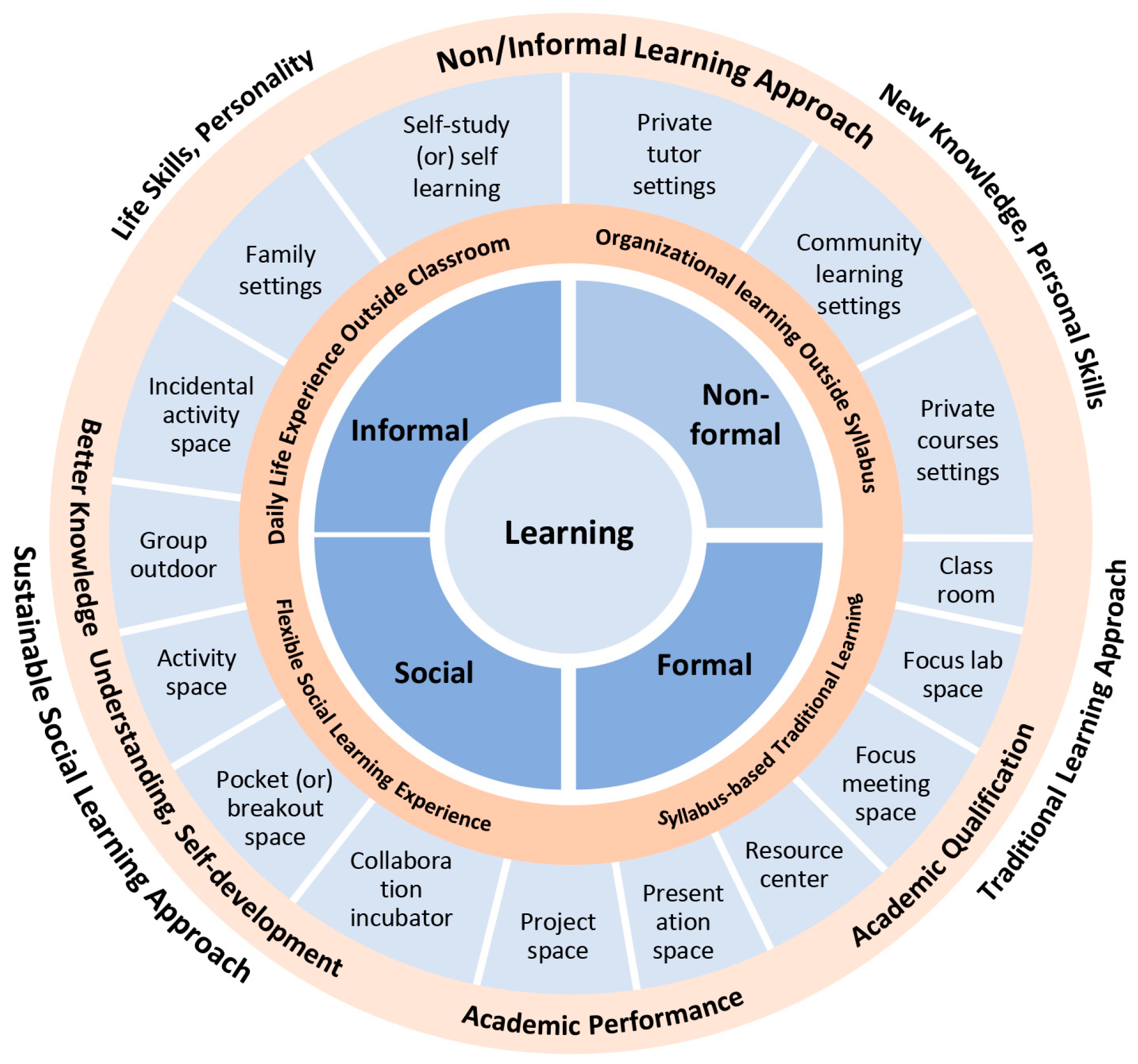
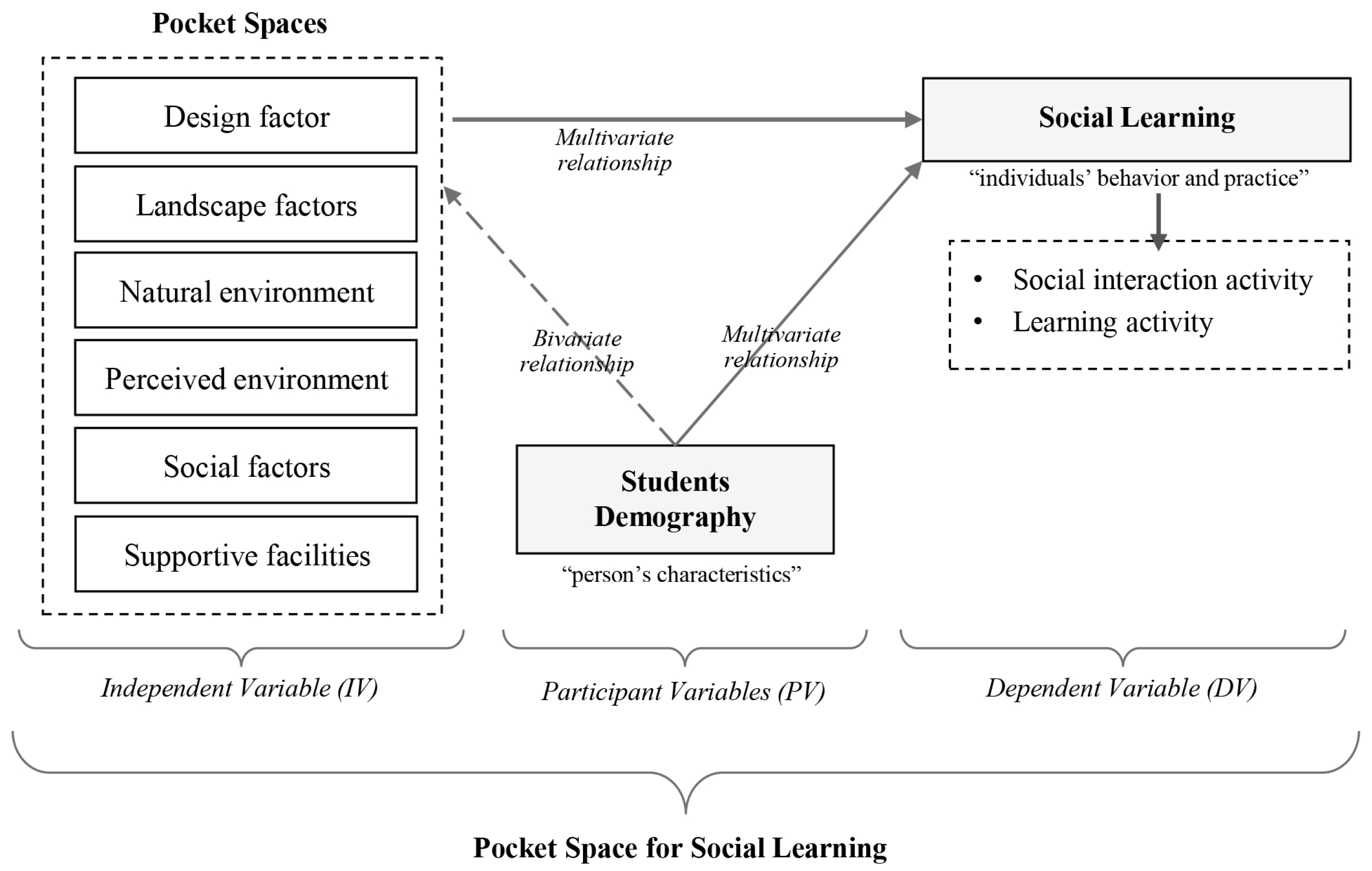
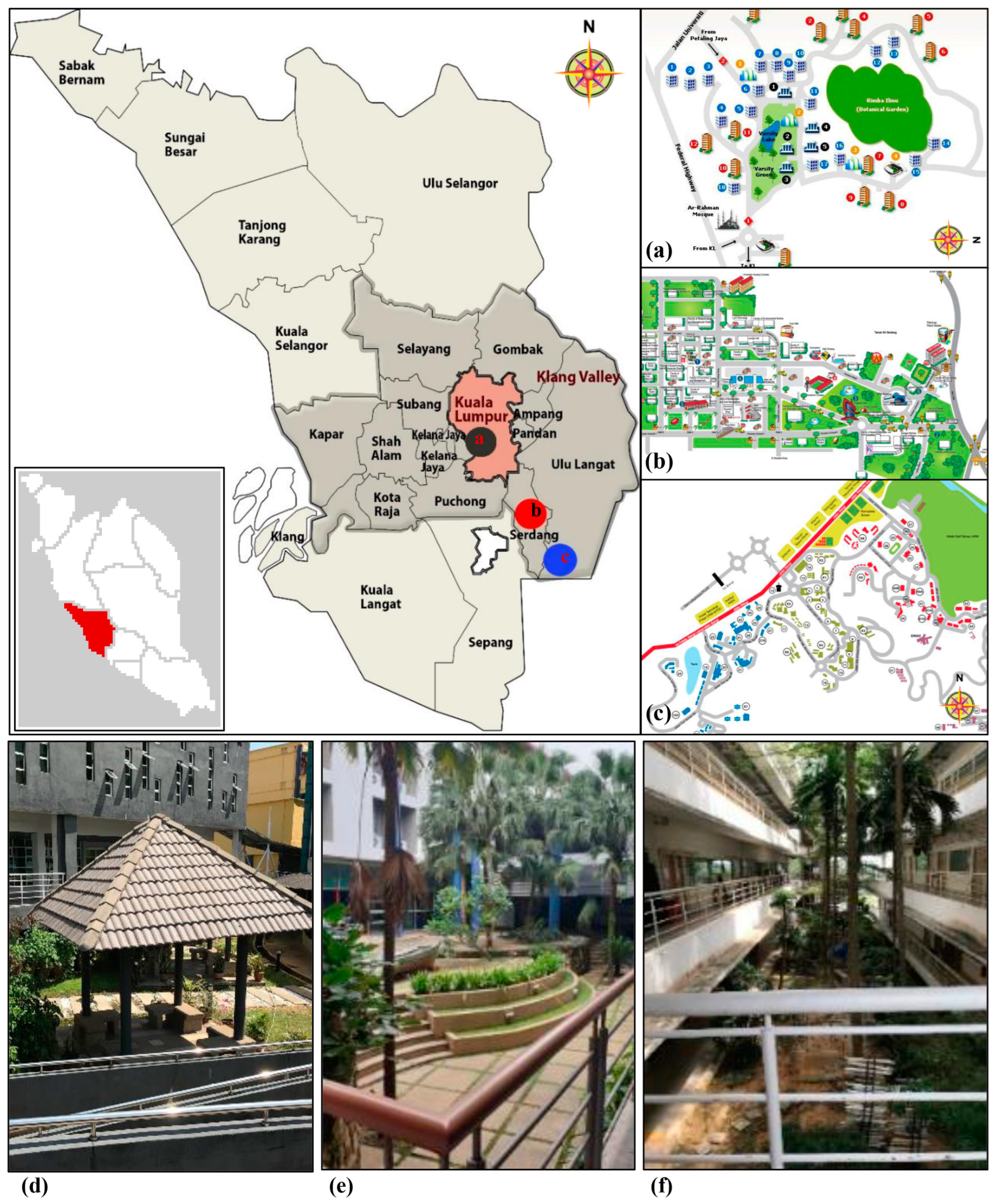
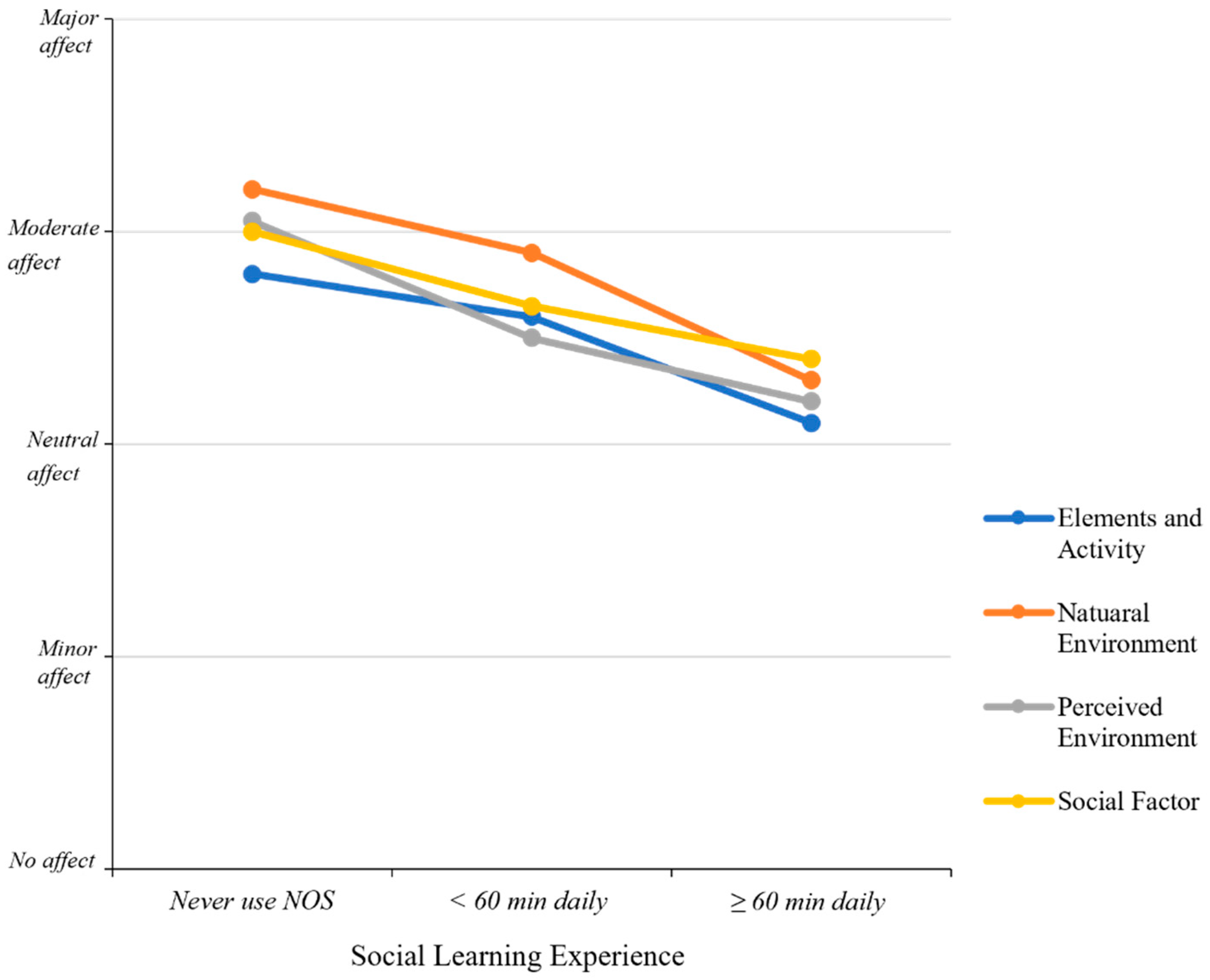
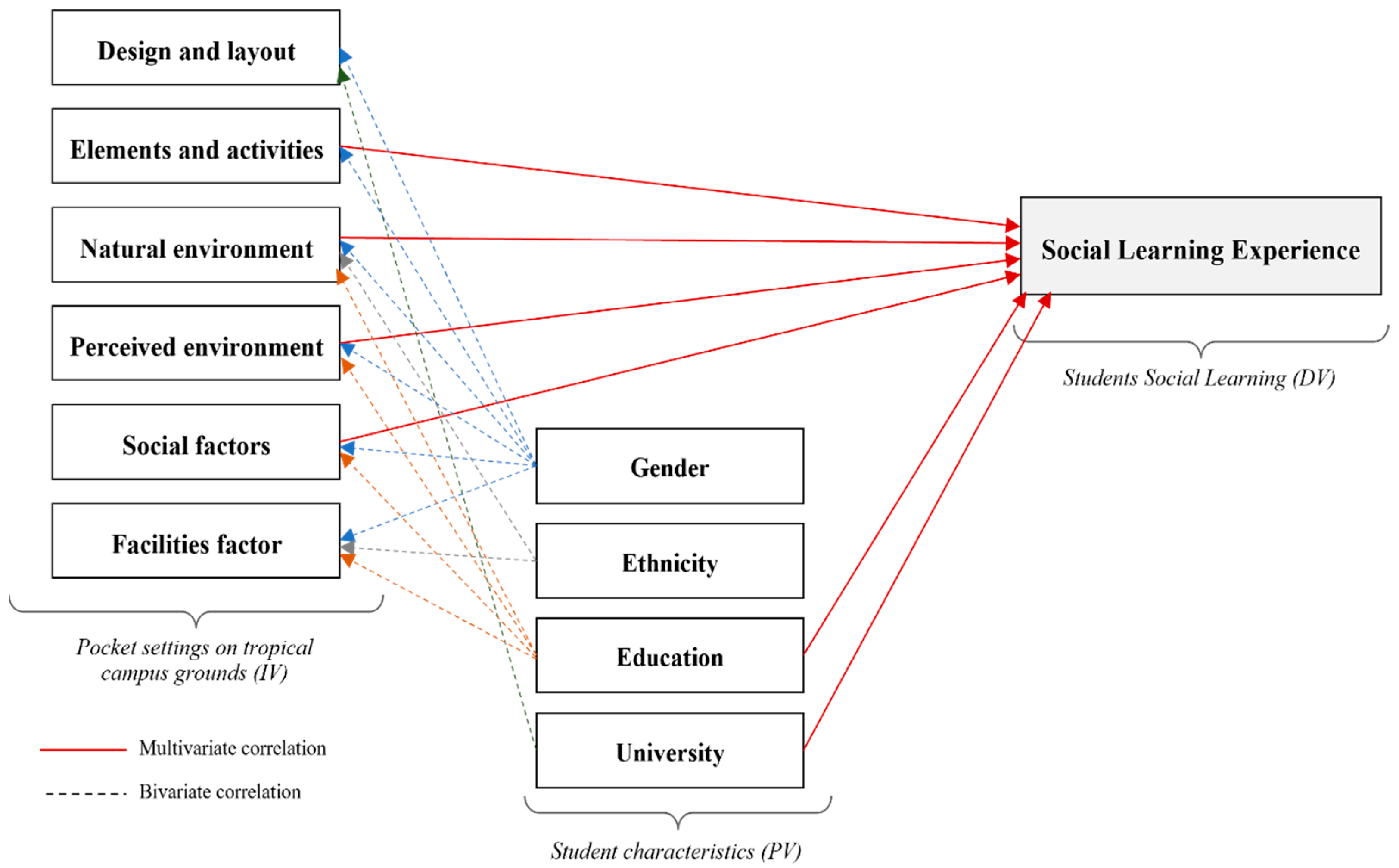
| Items | Description | FL (>0.70) | CA (>0.70) | References | |
|---|---|---|---|---|---|
| Demographics | Item-a | Gender | 0.753 | 0.812 | [13,14] |
| Item-b | Ethnicity | 0.731 | 0.819 | ||
| Item-c | Education level | 0.743 | 0.813 | ||
| Item-d | University affiliation | 0.789 | 0.816 | ||
| Design and layout | Item-a | Well-designed | 0.732 | 0.702 | [26] |
| Item-b | Easy access | 0.702 | |||
| Elements and activities | Item-a | Hardscape | 0.780 | 0.708 | [14,19,42] |
| Item-b | Softscape | 0.775 | |||
| Item-c | Sense elements | 0.762 | |||
| Item-d | Activities | 0.715 | |||
| Natural environment | Item-a | Temperature | 0.723 | 0.735 | [13,26,27,42] |
| Item-b | Rain and humidity | 0.820 | |||
| Item-c | Wind | 0.707 | |||
| Item-d | Sunlight | 0.662 * | |||
| Item-e | Shade | 0.832 | |||
| Perceived environment | Item-a | Management and maintenance | 0.739 | 0.713 | [43,54] |
| Item-b | Safety and security | 0.721 | |||
| Facilities | Item-a | Connectivity | 0.782 | 0.780 | [2,27] |
| Item-b | Refreshment | 0.752 | |||
| Item-c | Resources | 0.732 | |||
| Social factor | Item-a | Existence of other | 0.704 | 0.715 | [41,43] |
| Item-b | Participation in socialisation | 0.747 | |||
| Social learning experience | Item-a | Socialisation (chatting and conversation) | 0.764 | 0.816 | [14,26,41,43] |
| Item-b | Social, recreational | 0.742 | |||
| Item-c | Social refreshment | 0.711 | |||
| Item-d | Other social activities | 0.632 * | |||
| Item-e | Informal group learning | 0.701 | |||
| Item-f | Informal individual learning | 0.706 | |||
| Item-g | Formal learning | 0.703 |
| Variable | Frequency | % | Ranges | Total | Missing | |
|---|---|---|---|---|---|---|
| Gender | Male | 203 | 49.7 | 1–2 | 408 | - |
| Female | 205 | 50.2 | ||||
| Ethnicity | Malay | 191 | 46.8 | 1–4 | 408 | - |
| Chinese | 121 | 29.7 | ||||
| Indian | 38 | 9.3 | ||||
| Others | 58 | 14.2 | ||||
| Education status | Bachelor | 191 | 46.8 | 1–3 | 408 | - |
| Masters | 159 | 39.0 | ||||
| PhD | 58 | 14.2 | ||||
| University | UM | 100 | 24.1 | 1–3 | 408 | - |
| UPM | 150 | 36.1 | ||||
| UKM | 158 | 38.1 | ||||
| Social learning experience | Never use nearby pock | 183 | 44.8 | 1–3 | 408 | - |
| <60 min daily | 190 | 46.6 | ||||
| ≥60 min daily | 35 | 8.2 |
| Variables | Mean ± SD | Values | 1 | 2 | 3 | 4 | 5 | 6 | 7 | 8 | 9 | 10 | 11 | |
|---|---|---|---|---|---|---|---|---|---|---|---|---|---|---|
| 1 | Social Learning | 1.55 ± 0.434 | (1–3) *** | - | ||||||||||
| 2 | Gender | - | - | −0.080 | - | |||||||||
| 3 | Ethnicity | - | - | −0.269 ** | −0.109 * | - | ||||||||
| 4 | Education Status | - | - | −0.406 ** | −0.110 * | 0.505 ** | - | |||||||
| 5 | University | - | - | 0.242 ** | 0.003 | −0.088 | −0.111 * | - | ||||||
| 6 | Design and Layout | 3.55 ± 1.060 | −0.011 | −0.149 ** | 0.100 | −0.082 | 0.110 * | - | ||||||
| 7 | Elements and Activities | 3.74 ± 0.722 | (1–5) **** | −0.270 ** | −0.191 ** | 0.085 | −0.049 | 0.055 | 0.515 ** | - | ||||
| 8 | Natural environment Factors | 3.94 ± 0.727 | (1–5) **** | −0.304 ** | −0.284 ** | −0.151 ** | −0.259 ** | 0.022 | 0.465 ** | 0.526 ** | - | |||
| 9 | Perceived environment factor | 3.58 ± 0.951 | (1–5) **** | −0.098 * | −0.220 ** | 0.044 | −0.120 * | 0.082 | 0.550 ** | 0.407 ** | 0.462 ** | - | ||
| 10 | Social factor | 3.69 ± 0.678 | (1–5) **** | −0.234 ** | −0.237 ** | 0.038 | −0.158 ** | 0.023 | 0.315 ** | 0.438 ** | 0.441 ** | 0.287 ** | - | |
| 11 | Facilities factor | 3.66 ± 0.776 | (1–5) **** | −0.114 * | −0.106 * | −0.168 ** | −0.135 ** | 0.100 * | 0.222 ** | 0.182 ** | 0.207 ** | 0.175 ** | 0.206 ** | - |
| Variables: Influencing Factors | Model 1 | Model 2 | ||
|---|---|---|---|---|
| β | Sig. | β | Sig. | |
| (Constant) | 0.000 *** | 0.000 *** | ||
| Ethnicity | −0.085 | 0.098 | −0.874 | 0.382 |
| Education status | −0.356 | 0.000 *** | −5.835 | 0.000 *** |
| University | 0.194 | 0.000 *** | 3.757 | 0.000 *** |
| Elements and activities | −0.136 | 0.012 ** | ||
| Natural environment factors | −3.648 | 0.000 *** | ||
| Perceived environment factor | −3.370 | 0.001 ** | ||
| Social factor | −0.138 | 0.017 * | ||
| Facilities factor | −1.065 | 0.288 | ||
Disclaimer/Publisher’s Note: The statements, opinions and data contained in all publications are solely those of the individual author(s) and contributor(s) and not of MDPI and/or the editor(s). MDPI and/or the editor(s) disclaim responsibility for any injury to people or property resulting from any ideas, methods, instructions or products referred to in the content. |
© 2023 by the authors. Licensee MDPI, Basel, Switzerland. This article is an open access article distributed under the terms and conditions of the Creative Commons Attribution (CC BY) license (https://creativecommons.org/licenses/by/4.0/).
Share and Cite
Alzamil, W.; Salih, S.A.; Ismail, S.; Ajlan, A.; Azmi, A. Factors Affecting Social Learning in Nearby Pockets on Tropical Campus Grounds: Towards a Sustainable Campus. Sustainability 2023, 15, 16581. https://doi.org/10.3390/su152416581
Alzamil W, Salih SA, Ismail S, Ajlan A, Azmi A. Factors Affecting Social Learning in Nearby Pockets on Tropical Campus Grounds: Towards a Sustainable Campus. Sustainability. 2023; 15(24):16581. https://doi.org/10.3390/su152416581
Chicago/Turabian StyleAlzamil, Waleed, Sarah Abdulkareem Salih, Sumarni Ismail, Ali Ajlan, and Athira Azmi. 2023. "Factors Affecting Social Learning in Nearby Pockets on Tropical Campus Grounds: Towards a Sustainable Campus" Sustainability 15, no. 24: 16581. https://doi.org/10.3390/su152416581
APA StyleAlzamil, W., Salih, S. A., Ismail, S., Ajlan, A., & Azmi, A. (2023). Factors Affecting Social Learning in Nearby Pockets on Tropical Campus Grounds: Towards a Sustainable Campus. Sustainability, 15(24), 16581. https://doi.org/10.3390/su152416581








